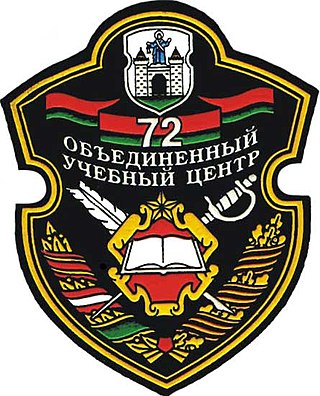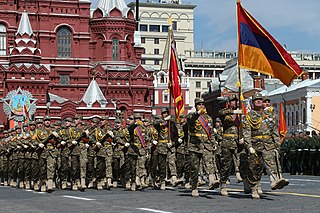The Northern Front was a front of the Red Army during the Second World War.

The 2nd Guards Tatsinskaya Tank Corps was a tank corps of the Soviet Union's Red Army that saw service during World War II on the Eastern Front of Europe. The unit's most notable moment was in the raid on Tatsinskaya during Operation Little Saturn in World War II. After the war, it continued to serve with the Soviet occupation forces in Central Europe. It was originally the 24th Tank Corps. The formation had approximately the same size and combat power as a Wehrmacht Panzer Division, and less than a British Armoured Division had during World War II.
The 110th Rifle Division was a formation of the Soviet Union's Red Army during the course of World War II, which was formed, dissolved, and re-formed three times throughout the war.
The 75th Guards Rifle Division was a Red Army infantry division during World War II and afterwards, which later became the 75th Guards Tank Division and was finally disbanded in the 1990s.
The 51st K. E. Voroshilov Guards Vitebsk Order of Lenin Red Banner Rifle Division was an infantry division of the Red Army during World War II that continued serving in the Soviet Army in the early years of the Cold War.
The 40th Guards Rifle Division was one of a series of ten Guards rifle divisions of the Red Army formed from airborne troops in the spring and summer of 1942 in preparation for, or in response to, the German summer offensive. It fought in the Stalingrad area during that battle, eventually in the operations that encircled German 6th Army, and then continued to serve in the several campaigns in the south sector of the front, helping to liberate Ukraine and the Balkans, and ending the war at Vienna.
The 23rd Rifle Division was an infantry division of the Red Army and Soviet Army, formed three times.
The 69th Rifle Division was an infantry division of the Red Army and later the Soviet Army, formed twice.
The 34th Rifle Division was an infantry division of the Red Army during and before World War II. The division was formed in 1923. It fought in the Soviet invasion of Manchuria in August 1945. Postwar, it became the 11th Machine Gun Artillery Division.
The 105th Guards Airborne Division was an airborne division of the Soviet Airborne Troops.
The 37th Guards Rechitsa, twice Red Banner, Orders of Suvorov, Kutuzov, and Bogdan Khmelnitsky Rifle Division was an infantry division of the Red Army which fought during World War II.
The 47th Rifle Division was an infantry division of the Red Army. It was first formed in 1922 as the Georgian Rifle Division. In 1924, it became the 1st Georgian Mountain Division. The division became the 47th Georgian Mountain Rifle Division in 1936 and dropped the designation "Georgian" in 1940. It was disbanded in June 1942 after being wiped out at Izyum. In July 1942, the 47th Rifle Division was formed from the 21st Rifle Brigade. It fought in the Nevel Offensive, for which it was awarded the title "Nevel". The division was disbanded in the Baltic Military District in 1946. It was also awarded the Order of Lenin and the Order of Suvorov 2nd class. The division was reformed a third time from the 277th Rifle Division in 1955 but disbanded in July 1956.
The 103rd Rifle Division was an infantry division of the Red Army, formed three times. It was first formed in 1939. It was converted into a motorized division and fought in the Yelnya Offensive. After being converted back to a rifle division it was destroyed in the Battle of Vyazma. The division reformed in early 1942 but was destroyed during the Second Battle of Kharkov. It was reformed a third time in the Far East in summer 1942 and participated in the Soviet invasion of Manchuria.
The 79th Motor Rifle Division was a motorized infantry division of the Soviet Army. It was converted from the 79th Rifle Division in 1957 and inherited the honorific "Sakhalin". The division was awarded the Order of the Red Banner. The 79th Rifle Division fought in the Invasion of South Sakhalin in 1945 and was based at Leonidovo for most of its career.

The 72nd Guards Joint Training Centre is a training centre of the Belarus Armed Forces. It trains warrant officers and junior specialists for the Belarus Armed Forces and is based in Borisov. The 72nd Guards Joint Training Centre traces its history back to the Soviet 120th Rifle Division. For its actions during the Yelnya Offensive, the division became the 6th Guards Rifle Division in September 1941. In November 1945, the division became the 15th Guards Mechanized Division. On 15 May 1957, it became the 47th Guards Tank Division. The division became a training unit in 1960 and was renamed the 45th Guards Tank Training Division in 1965. In 1987, it became the 72nd Guards District Training Centre. In 1992, it was taken over by Belarus and became the 72nd Guards Joint Training Centre.
The 49th Rifle Division was a Soviet Army infantry division, formed three times. First formed as a territorial division in 1931, the 49th Rifle Division's first formation became a regular division by 1939 and fought in the Winter War. For its actions during the war, it was awarded the Order of the Red Banner. However, the 49th Rifle Division was wiped out during the first ten days of Operation Barbarossa. Its second formation occurred in December 1941 and fought at Stalingrad, Kursk, the Vistula-Oder Offensive and the Battle of Berlin. The second formation was disbanded in 1946. The division was reformed in 1955 by renaming the 295th Rifle Division and became the 49th Motor Rifle Division in 1957.
The 62nd Rifle Division was an infantry division of the Soviet Union's Red Army, formed four times and active during World War II and the postwar period. The division was formed in 1936 and fought in the Winter War and Soviet occupation of Bessarabia and Northern Bukovina. It was destroyed during the Battle of Kiev in summer 1941. The division was reformed in November 1941. It fought in the defense against the German offensive Case Blue during the summer of 1942. After suffering heavy losses, it was withdrawn from combat but was sent back to fight in the Battle of Stalingrad in November. The division suffered heavy losses and was disbanded on 2 November. The division was reformed a third time from a rifle brigade in April 1943. It fought in Operation Suvorov, Operation Bagration, the East Prussian Offensive and the Prague Offensive. It was disbanded in the summer of 1945. The 62nd was reformed a fourth time by renaming the 360th Rifle Division, but became the 108th Motor Rifle Division in 1957.
The 166th Rifle Division was an infantry division of the Soviet Union's Red Army that fought in World War II, formed twice. The division's first formation was formed in 1939 and wiped out in the Vyazma Pocket in October 1941. In January 1942, the division reformed. It fought in the Battle of Demyansk, the Battle of Kursk, Belgorod-Khar'kov Offensive Operation, Vitebsk–Orsha Offensive, Polotsk Offensive, Šiauliai Offensive, Riga Offensive and the Battle of Memel. It was awarded the Order of the Red Banner.

A national military formation refers to a regiment/division in the Soviet Red Army of the Soviet Union, formed before and during the Second World War on the basis of nationalities of the personnel in their ranks. In addition to national units, representatives of all nationalities served in ordinary military formations not divided according to national or other grounds.



